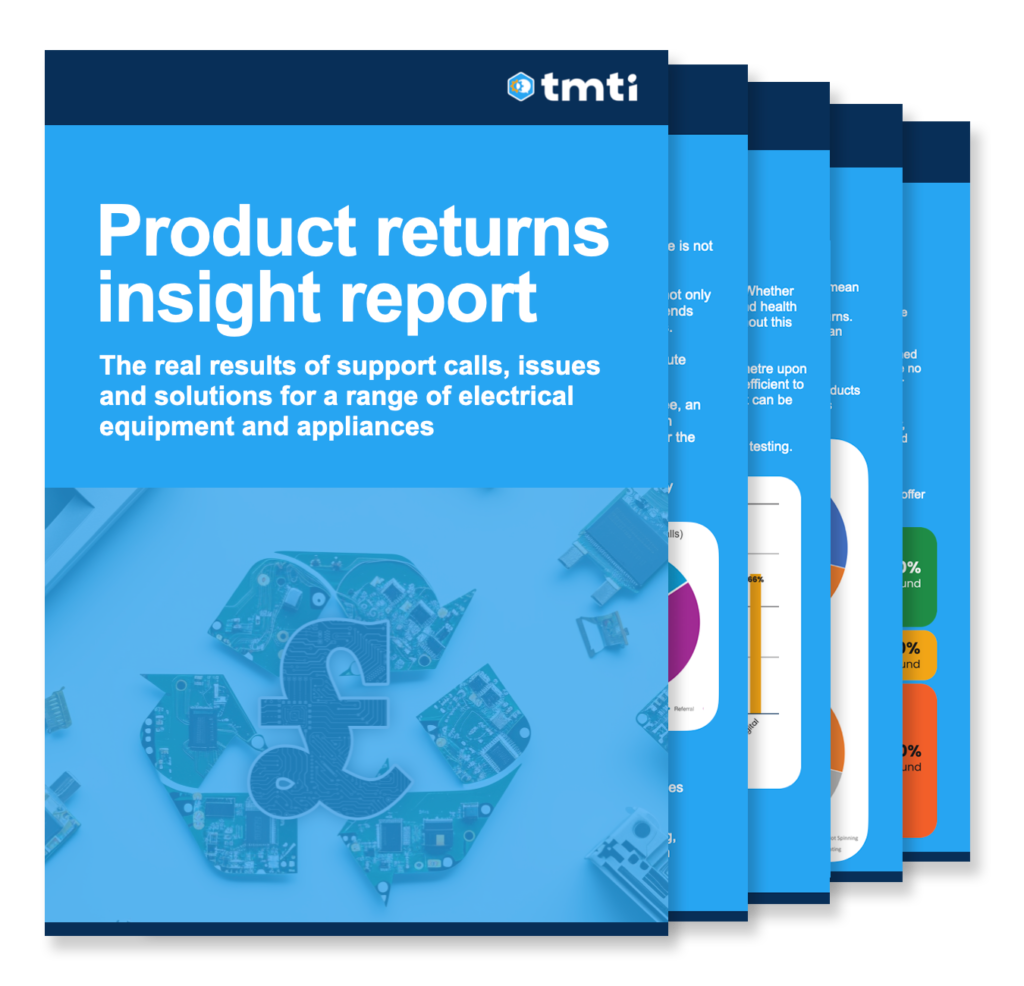Turning challenges into opportunities
In this blog post, we’ll explore how to make a profit from your returns or, in other words, how to monetise them.
To understand the magnitude of the issue, let’s first delve into the staggering amount of waste ending up in UK landfills each year. If you look at just electrical waste alone, 360,000 tonnes of WEEE collected from UK households in Quarters 1-3 of 2023 ended up in landfill – source [Statista]
Although much of this e-waste is out of the control of companies as it’s coming straight from household recycling and waste schemes, there are steps you can take to help reduce the levels of needless waste and even increase profits in the process.
The pain is also reflected in the business world with the potential mountains of stock returned as broken. In recent years businesses have come under increased pressure to take more accountability for the products, their sustainability and how they manage their waste.

At TMTI we’ve been helping clients to reduce the volume of product returns and in the last few years we’ve developed strategies that really work to make dead stock profitable again.
How to generate profit from product returns
Product returns have long been viewed as an inevitable and costly aspect of the retail business. However, what if we told you that there’s a way to not only mitigate the financial impact of returns, but also a way to turn products returns into profit?
Contrary to popular belief, dead stock isn’t always as lifeless as it seems. Some items are returned due to customer dissatisfaction or ‘we hate to say it’ as an excuse to get a refund as they’ve changed their minds, but they may still be serviceable.
The key lies in what you do with returns and how you manage the process. Here are 3 ways we help clients to profit from product returns and reduce the number of returns in the first place.
1. Grading, testing, and stripping for spares.
All of these stages can help separate the wheat from the chaff, taking the most serviceable parts for the next stages.
- Grading the quality of product returns will firstly separate out the cream of the crop and quickly identify the returns that can quickly be turned back to profit. On average we find at least 30% of returned stock (and up to 60% for some products such as games consoles) have no fault found and with a small degree of cleaning, is ready for resale after quality testing.
- Testing is vital to the resale of spares and parts. Whether that be responsivity tests for game controllers or battery charge and health checks for rechargeable’s. It’s pointless to begin a resale plan without this vital step. It’s no surprise for me to walk through the office in the morning and find metre upon metre of gaming controllers running battery tests!
- Finally, the definitely dead stock. But is it definitely, dead? There’s still something to be taken from these! Many products are built fairly modular by nature, so where some parts may have failed on one product, they may be fine in another, stripping for spares simply adds free parts for you to re-assemble into re-born working models. Money saved and sales opportunities created!

2. Reselling returned stock and parts
So once you have the returned stock, what’s next? Resale!
Whether through your brand’s website, a support partner, subsidiary or a third-party platform like eBay, profits can be made from items that were once deemed valueless.
All of the avenues for reselling come with their own sets of costs and caveats. For example, keeping your returns processes in house may keep the control in-house, however, this could eat into any profits gained when trying to manage the peaks and troughs and learn as you go. It may also get overwhelming at scale.
Other businesses may outsource, which will usually come at a higher cost due to management charges and handling fees. However, the costs are often more manageable, predictable and sometimes absorbed by the outsource partner, which can ultimately lead to greater profits. A specialist outsource partner will also be able to share their expertise and learning gained through different strategies.
3. Returns prevention & technical support
While managing returns is essential, and making them profitable is a bonus, the real dream is to not have the product returns in the first place! Yes, this may seem idealistic, but reducing the volume by focusing on returns prevention can be a game-changer.
Offering a higher level of technical support as part of the after-sales care for your products and including it in your companies returns process can save money in the long run. It can ensure that customers have been through a more thorough level of technical support before initiating a return. In many cases, this itself can reduce returns volumes simply by resolving customers issues and fixing what was previously “broken”, over the phone.
Now we might be a Technical Support and Returns Prevention company. And yes, it may seem like we’re tooting our own trumpet, but we know support and prevention works and our data says the same.
81%* of support calls we take can be resolved on the first call, this prevents huge amounts of unnecessary returns and costs for our clients every day. (*Based on an average 500,000 contacts a year)
If no resolution is found, technical support can also be used similar to a guarantor or verifier. Helping to validate returns whilst capturing data on issues, providing insight into trends and potential issues back to clients.

The importance of creating a better product returns experience
Product returns come with their fair share of challenges, including high logistics costs, dead or written-off stock and expensive replacement costs. These are only the physical ingrained costs of the chain but that’s really just the start.
If you also consider the potential damage to your brand, it’s no surprise most businesses want an effective product returns process that’s as seamless as possible. A poor returns journey can lead to excessive time waiting for product swaps, or create multiple hoops for customers to jump through. This creates frustration and can be extremely detrimental. Some studies show that customers are 58% more likely to switch brands or retailers due to poor customer service and over 50% choosing to switch for an easier customer experience.
For retailers, the returns management process can prove even more of a challenge due to the number of manufacturers and suppliers involved throughout the returns journey.
One thing often overlooked is the power of analytics. We help our clients to unlock the insight in their data and reduce product returns by consolidating data from various sources like retail, manufacturing, logistics and repair reports. This 360-degree view helps identify patterns and root causes, enabling them to make data-driven decisions to reduce product returns and improve profitability.

Benefits of a Returns Support Journey
Having the plan for a returns support journey mapped out is vital for profit and for future proofing new product rollouts as much as it is for end of life and faulty stock.
With the rise of self service and AI automation, the expectation of customers regarding the returns process is growing rapidly. Ensuring you have the intelligence and processes behind the returns journey, and knowing what to do with the stock that is returned will help you manage the flow of products in and out of the business with control and precision.
As mentioned above, implementing a robust returns support journey not only makes the process stress-free for customers but also protects your brand. Customers are more likely to stick with brands that provide a pain-free returns experience, fostering confidence that they aren’t just treated as sales receipts.

So, can product returns really be profitable?
In conclusion, transforming returns from a financial burden into a lucrative opportunity requires strategic thinking, insight, effort and a customer-centric approach. By understanding the nuances of returns, the data driving the reasons behind them and how to implement an effective returns support journey, plus exploring innovative ways to resell previously rejected stock, retailers can not only minimise losses but also turn product returns into profit.
Other points we’ve not even scratched the surface on in this post come from the enormous benefit to the planet and companies aiming to hit sustainability goals. If you can prevent a return in the first place or resell returned products, you will increase a products life cycle AND keep them out of the landfill for longer!
Take a look at our new Product Returns Insight Report, where we share the real results and figures for support calls, issues raised and solutions for a range of electrical equipment and domestic appliances.
Download Report

At TMTI we specialise in technical support and returns prevention as well as returns management. Whether you are looking for a full service support partner or just help setting up an eBay resale shop for your product returns, we can help! If you’d like to know more about how we help our clients, drop us an email or give us a call. TMTI stands for Talk Me Through It, and that’s what we’d be more than happy to do.



